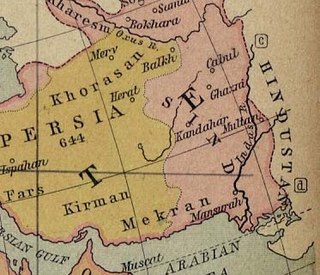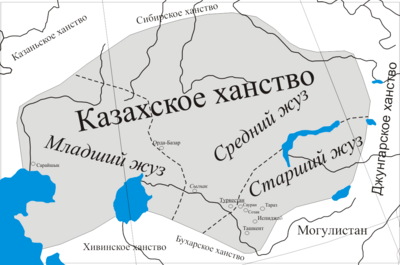
Muhammad Shaybani Khan was an Uzbek leader who consolidated various Uzbek tribes and laid the foundations for their ascendance in Transoxiana and the establishment of the Khanate of Bukhara. He was a Shaybanid or descendant of Shiban, the fifth son of Jochi, Genghis Khan's eldest son. He was the son of Shah-Budag, thus a grandson of the Uzbek conqueror Abu'l-Khayr Khan.
Muhammad Qasim bin Janibek Khan, known by his shortened regal name as Qasim Khan was a son of Janibek Khan. He ruled as the fourth Khan of the Kazakh Khanate from about 1511 to 1521. He is viewed as the greatest leader to unite the Kazakh tribes. Although, Burunduk Khan was the Khan of the Kazakhs, the control of the government was in the hands of Qasim Khan. Eventually, he sent Burunduk Khan into exile who died in Samarkand. Qasim Khan had a brother named Adik Khan who was married to Sultana Nigar Khanim, daughter of Yunus Khan of Moghulistan. When Adik Khan died, Qasim Khan took her as his wife.

The Uzbek Khanate, also known as the Abulkhair Khanate, was a Shaybanid state preceding the Khanate of Bukhara. During the few years it existed, the Uzbek Khanate was the preeminent state in Central Asia, ruling over most of modern-day Uzbekistan, much of Kazakhstan and Turkmenistan, and parts of southern Russia. This is the first state of the Abulkhairids, a branch of the Shaybanids.
Tughlugh Timur Khan (1312/13–1363) was the Khan of Moghulistan from c. 1347 and Khan of the whole Chagatai Khanate from c. 1360 until his death. Esen Buqa is believed to be his father. His reign is known for his conversion to Islam and his invasions of Transoxiana.

The Kazakh Khanate, in eastern sources known as Ulus of the Kazakhs, Ulus of Jochi, Yurt of Urus, was a Kazakh state in Central Asia, successor of the Golden Horde existing from the 15th to the 19th century, centered on the eastern parts of the Desht-i Qipchaq.

Esen Buqa II was Khan of Moghulistan from 1429 until his death. He was the younger son of Uwais Khan.

Yunus Khan, was Khan of Moghulistan from 1462 until his death in 1487. He is identified by many historians with Ḥājjī `Ali, of the contemporary Chinese records. He was the maternal grandfather of Babur, founder of the Mughal Empire.
Sultan Mahmud Khan, was Khan of Tashkent and of the Moghuls of western Moghulistan (1487–1508). He was the eldest son of Yunus Khan. He was born in 1464, his mother was Shah Begum, daughter of Badakhshan prince Lali, who claimed his descent from Alexander the Great and gave one of his six daughters to Yunus Khan in marriage, pleasing his request.

Moghulistan, also called the Moghul Khanate or the Eastern Chagatai Khanate, was a Mongol breakaway khanate of the Chagatai Khanate and a historical geographic area north of the Tengri Tagh mountain range, on the border of Central Asia and East Asia. That area today includes parts of Kazakhstan, Kyrgyzstan, and northwest Xinjiang, China. The khanate nominally ruled over the area from the mid-14th century until the late 17th century.

Mirza Muhammad Haidar Dughlat Beg was a Chagatai Turco-Mongol military general, governor of Kashmir, and a historian. He was a Mughal Dughlat prince who wrote in both Chaghatai and Persian languages. Haidar and Babur were cousins on their mother's side, through the line of Genghis Khan. Unlike Babur, Haidar considered himself more of an ethnic Mongol of Moghulistan.

The Dughlat clan was a Mongol clan that served the Chagatai khans as hereditary vassal rulers of several cities in western Tarim Basin, in modern Xinjiang, from the 14th century until the 16th century. The most famous member of the clan, Mirza Muhammad Haidar, was a military adventurer, historian, and the ruler of Kashmir (1541–1551). His historical work, the Tarikh-i Rashidi, provides much of the information known about the family.

In 1504, Babur besieged Kabul and took the city from the Arghuns under Mukim Beg Arghun, to become the new king of Kabul and Ghazni regions. The territory gave him respite from his Uzbek troubles in Central Asia. It allowed him to build his nascent kingdom into a strong and formidable power in later years, enough to conquer northern India.

Qamar-ud-din Khan Dughlat Muslim was a Moghul ruler of Moghulistan between 1368 and 1392. He belonged to the Dughlat clan of Mongol warlords. He Was Not Descendant Of Genghis Khan Or Chagatai Khan

In the early 16th century, Sultan Mahmud Khan, the Chagatai Khan of Western Moghulistan, and Sultan Ahmad Alaq Khan, the Chagatai Khan of Eastern Moghulistan, decided to counter the growing power of the Uzbeks under Muhammad Shaybani. Sultan Ahmed Tambol had rebelled against his Timurid master Babur and declared his independence. But when Babur tried to reconquer his territory with the help of his uncles, Ahmed Tambol sought the assistance of the Uzbeks. The two Moghul brothers united their forces and launched a campaign against Tambol, but Muhammad Shaybani surprised the Khans and proved victorious in battle of Akhsi and took them both prisoner.

After the Uzbeks were driven out of Samarkand in early 1501 CE, they regrouped in Bukhara. Muhammad Shaybani began to prepare for another attempt to take Samarkand in April - May 1501 CE. Babur, the Timurid leader, decided to meet this threat before it arrived at the city. The two armies met at Sar-e-Pul, where a decisive battle was fought which decided the fate of the Timurids and of the region, resulting in gradual conquest of Transoxiana, Khwarezm and Khorasan by the Uzbeks.

Battle of Ab Darrah Pass was the battle that took place in 1511 in the place called Ab Darrah between Uzbeks and Babur of Timurids. The battle ended with the decisive Timurid victory which enabled Babur to regain Transoxiana and briefly reunite the whole of the ancestral part of the Timurid Empire. Such a decisive and significant battle is not mentioned in Babur’s Memoirs (Baburnama), in which there is a break from the year 1508 to the beginning of 1519.
Eastern Afghanistan Operations was when Uzbek Khan and Muhammad Shaybani surrounded Kandahar, Babur found his developing Kingdom of Kabul in danger. He feared that Kabul would be the next target of the Uzbeks.

The Battle of the Chirciq River was fought between Sultan Mahmud Khan of Moghulistan and Sultan Ahmed Mirza, the Timurid ruler of Samarkand & Bukhara in 1488 CE over the city of Tashkent. The Moghuls decisively defeated the Timurids as a result of the defection of 3,000 Uzbeks under the command of Muhammad Shaybani Khan.
The Kazakh War of Independence (1468–1500) was a conflict fought in Central Asia between the Kazakh Khanate and the Uzbek Khanate, which attempted to maintain its control over most of modern-day Kazakhstan, which at the time was under Uzbek rule. The war started after Abu'l-Khayr, Khan of the Uzbek Khanate, attacked Zhetysu in 1468 which was controlled by a small band of rebel Kazakhs who had split from the original Uzbek Khanate. Abu’l Khayr did so in an attempt to prevent the growing Kazakh influence among the steppe. However, he died unknowingly, making it easier for the Kazakhs to expand their influence. After Abu'l-Khayr Khan's death, the Uzbeks continued to be ruled by the Shaybanids who fought against the Kazakhs in the cities that were on the Syr Darya until both sides agreed to peace in 1500 with the Kazakh Khanate gaining its sovereignty from the Uzbek control. At the end of the war, the Uzbek Khanate transferred most of Kazakhstan to the Kazakh Khanate.
Haqnazar Haider Sultan bin Qasim Khan, commonly known as Haqnazar Khan, was the khan of the Kazakh khanate from 1538-1580. He was the second-oldest son of Qasim Khan and the younger brother of Muhammed Khan.











